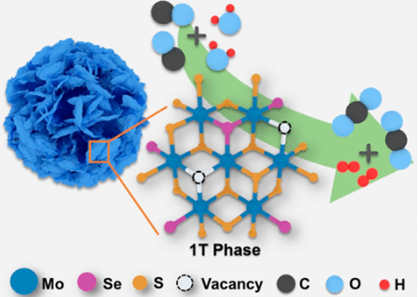Se-Incorporation Stabilizes and Activates Metastable MoS2 for Efficient and CostEffective Water Gas Shift Reaction
Ting Zhu†,§,#, Cheng Liu‡,#, Xinyue Tan†, Bin Huang§, Guo-Qing Bian†, Qi Shao*,†(邵琪), Shuxing Bai†, Yong Qian§, Youyong Li*,‡ (李有勇), and Xiaoqing Huang*,† (黄小青)
† College of Chemistry, Chemical Engineering and Materials Science, Soochow University, Suzhou, Jiangsu 215123, China
‡ Institute of Functional Nano & Soft Materials (FUNSOM), Soochow University, Suzhou, Jiangsu 215123, China
§ Jiangxi Province Key Laboratory of Polymer Micro/Nano Manufacturing and Devices, East China University of Technology, Nanchang, Jiangxi 330013, China
#T.Z. and C.L. contributed equally.
ACS Nano 2019, 13, 11303--11309
Although the water gas shift (WGS) reaction has sparked intensive attention for the production of high-purity hydrogen, the design of cost-efficient catalysts with noble metal-like performance still remains a great challenge. Here, we successfully overcome this obstacle by using Se-incorporated MoS2 with a 1T phase. Combining the optimized electronic structure, additional active sites from edge sites, and a sulfur vacancy based on the 1T phase, as well as the high surface ratio from the highly open structure, the optimal MoS1.75Se0.25 exhibits superior activity and stability compared to the conventional 2H-phase MoS2, with poor activity, large sulfur loss, and rapid inactivation. The hydrogen production of MoS1.75Se0.25 is 942 μmol, which is 1.9 times higher than MoS2 (504 μmol) and 2.8 times higher than MoSe2 (337 μmol). Furthermore, due to the lattice stabilization via Se-incorporation, MoS1.75Se0.25 exhibited excellent long-term stability without obvious change in more than 10 reaction rounds. Our results demonstrate a pathway to design efficient and cost-efficient catalysts for WGS.

链接:https://pubs.acs.org/doi/10.1021/acsnano.9b04444